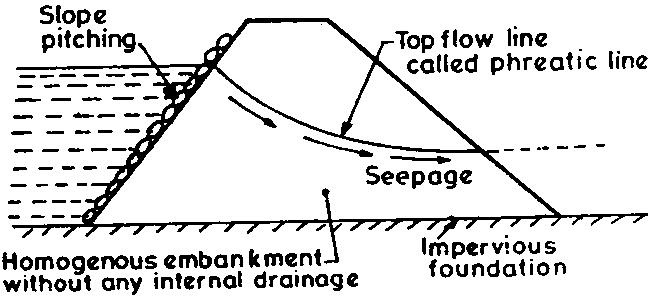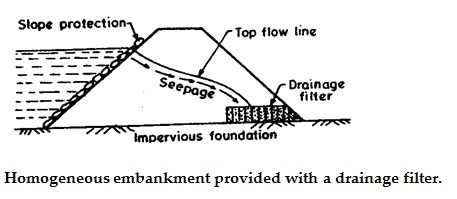Chapter: Civil : Water Resources and Irrigation Engineering : Diversion and Impounding Structures
Type of Earthen Dams
Type of Earthen Dams
The earthen dam can be of the following three types:
1. Homogeneous Embankment type
2. Zone embankment type
3. Diaphragm type.
These three types of dams are described below:

Figure: (a) Homogenous type embankment


Figure: Zoned type embankment
The central core checks the seepage. The transition zone prevents piping through cracks which may develop in the core. The outer zone gives stability to the central impervious fill and also distribute the load over a large area of foundations.
This type of embankment are widely constructed and the materials of the zones are selected depending upon their availabilities. Caly, inspite of it being highly impervious, may not make the best core, if it shrinks and swells too much. Due to this reason, clay is sometimes mixed with fine sand or fine gavel, so as to use it as the most suitable material for the central impervious core. Silts or silty clays may be used as the satisfactory central core materials. Freely draining materials, such as coarse sands and gravels, are used in the outer shell. Transition filters are provided between the inner zone and the outer zone, as shown in fig. This type of transition filters are always provided, whenever there is an abrupt change of permeability from one zone to the other.
(3) Diaphragm Type Embankments. Diaphragm type embankments have a thin impervious core, which is surrounded by earth or rock fill. The impervious core, called diaphragm, is made of impervious soils, concrete, steel, timber or any other material. It acts as a water barrier to prevent seepage through the dam. The diaphragm may be placed either at the centre as a central vertical core or at the upstream face as a blanket. The diaphragm must also be tied to the bed rock or to a very impervious foundation material, if excessive under-seepage through the existing previous foundations has to be avoided (fig.).

Figure: Diaphragm type embankment
The diaphragm type of embankments are differentiated from zoned embankments, depending upon the thickness of the core. If the thickness of the diaphragm at any elevation is less than 10 elevation is less than the height of the embankment above the corresponding
elevation, the dam embankment is considered to b equals or exceeds or exceeds these limits, it is considered to be of zoned embankment type.
Related Topics